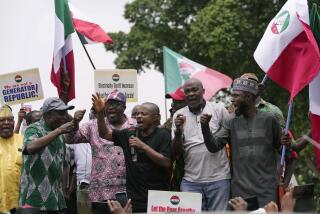Russia Faces Mass Strike, Sinking Ruble : Economy: Currency woes, one-day action by more than a million workers belie official optimism.
- Share via
MOSCOW — As more than a million disgruntled workers across the country staged warning strikes over the government’s failure to pay them, the ruble fell through the psychological barrier of 5,000 to the dollar Wednesday to belie official claims that Russia’s economic disaster has bottomed out.
The Russian currency now has lost half its value against the dollar in little more than six months.
The government also announced that it was boosting the minimum wage by 67% this month and 26% more after May 1 in moves likely to be popular with the impoverished masses but disastrous for a 1995 federal budget that critics contend was already built on illusions.
Finance Minister Vladimir G. Panskov disclosed a first-quarter revenue shortfall of $1.4 billion, or about 14% less revenue than calculated in the budget. That news appeared to corroborate independent economists who charged that the government inflated income projections to win the support of international lenders.
The signs of further economic decline came a day after the International Monetary Fund gave its final approval to a $6.8-billion standby credit granted on faith that President Boris N. Yeltsin’s leadership would stick by promises to hold down spending and inflation.
One economist called recent proclamations of impending stability “pure bluff,” and even some supporters of the government’s shaky stabilization program conceded that the Central Bank had been propping up the ruble for more than two weeks with huge cash infusions to stave off its fall through the 5,000 mark.
Wednesday’s woeful indicators follow other recent bad news, including failure to meet the government’s goal for reducing inflation last month to no more than 7%--the March figure was 8.9%--and indications that prices and unemployment are still on the rise.
Yeltsin’s chief economic aide, Alexander Livshits, described the ruble’s drop in currency trading to 5,008 against the dollar as “a symbolic figure which means nothing.”
The quasi-official Itar-Tass news agency noted the relative calm in financial circles after the discouraging milestone was passed, in sharp contrast with the chaos that ensued after the ruble broke through the 3,000-to-the-dollar barrier on Oct. 9. The Russian currency lost more than a quarter of its value in panic trading the next day, which came to be known as Black Tuesday.
The ruble fell to 4,000 against the dollar on Jan. 26, when concerns were stronger about Russia’s raging battle against the secessionist republic of Chechnya than over symbolic economic setbacks. That continuing war, however, is another drain on the economy unforeseen by budget planners.
In late March, the ruble was losing about 1% of its value against the dollar each day, but the Central Bank’s infusion of hard currency caused the decline to slow and even stop at times over the past two weeks.
“It was a wise move to slow down the dollar growth before the treaty with the IMF was signed,” said Nikolai Shmelev, an economist and chief researcher with the Institute of Europe in Moscow.
“But now the ruble will keep on falling faster than before,” Shmelev said, describing the Central Bank intervention as a time-buying maneuver at best.
At the same time the ruble fell to 5,008, Labor Minister Gennady G. Melikyan told the lower house of Parliament that the government was raising the minimum monthly wage from 20,500 rubles to 34,400 retroactive to April 1, or from the current equivalent of $4.09 to $6.87. The mandatory minimum, which is used as an index in calculating wages and benefits for most state workers, will go up again next month to 43,300 rubles, or $8.65 at the current exchange, Melikyan said.
Russian disenchantment with the protracted economic hardships inflicted by a decade of reform and upheaval was apparent in the rallies and warning strikes staged across the country by the Federation of Independent Trade Unions.
The labor alliance said more than 1.5 million workers took part in the protests in demand of 5.6 trillion rubles in back wages, or more than $1.1 billion owed by government enterprises smothering under debts left from the Soviet era.
A leader of the labor alliance, Alexei Surkov, threatened to call a nationwide strike to bring down the government unless it heeds Wednesday’s one-day warning.
More to Read
Sign up for Essential California
The most important California stories and recommendations in your inbox every morning.
You may occasionally receive promotional content from the Los Angeles Times.














